1982 street views of NYC
A bunch of street level panoramas of midtown Manhattan from 1982. 1982 has never seemed so long ago. This link has been up and down for the past two weeks so it may not be available, so bookmark it for later checking-out.



This site is made possible by member support. 💞
Big thanks to Arcustech for hosting the site and offering amazing tech support.
When you buy through links on kottke.org, I may earn an affiliate commission. Thanks for supporting the site!
kottke.org. home of fine hypertext products since 1998.
A bunch of street level panoramas of midtown Manhattan from 1982. 1982 has never seemed so long ago. This link has been up and down for the past two weeks so it may not be available, so bookmark it for later checking-out.
As part of his new-ish gig as editor of In Focus at The Atlantic, Alan Taylor is running a 20-week series of photo essays on World War II. The first essay, Before the War, has been posted and is excellent.
The years leading up to the declaration of war between the Axis and Allied powers in 1939 were tumultuous times for people across the globe. The Great Depression had started a decade before, leaving much of the world unemployed and desperate. Nationalism was sweeping through Germany, and it chafed against the punitive measures of the Versailles Treaty that had ended World War I. China and the Empire of Japan had been at war since Japanese troops invaded Manchuria in 1931. Germany, Italy, and Japan were testing the newly founded League of Nations with multiple invasions and occupations of nearby countries, and felt emboldened when they encountered no meaningful consequences. The Spanish Civil War broke out in 1936, becoming a rehearsal of sorts for the upcoming World War — Germany and Italy supported the nationalist rebels led by General Francisco Franco, and some 40,000 foreign nationals traveled to Spain to fight in what they saw as the larger war against fascism.
(thx, david)
Peter Langenhahn will take hundreds of photos at a sporting event and stitch them together to make a single time-compressed panorama of the event’s action, like this image of every foul committed during a soccer match. Here’s a short video showing how he does it.
See also Peter Funch’s composite NYC street scenes. (via petapixel)
There’s a great thread over at Quora with photos of famous people in unexpected places, situations, or company. For example, there’s a photo of a young Bill Clinton meeting John F. Kennedy and one of Mark Twain and Nikola Tesla hanging out. My two favorites are a photo of Tank Man captured from an unusual angle and a chilling photo of John Wilkes Booth at Lincoln’s second inauguration, taken a little over a month before he killed Lincoln.
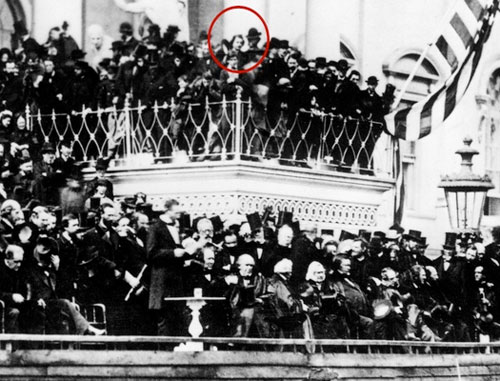
See also awesome people hanging out together. (thx, david)
No idea what these have to do with business or being inside business or whatever, but Business Insider has a nice selection of photos by Danny Lyon of Brooklyn in 1974.
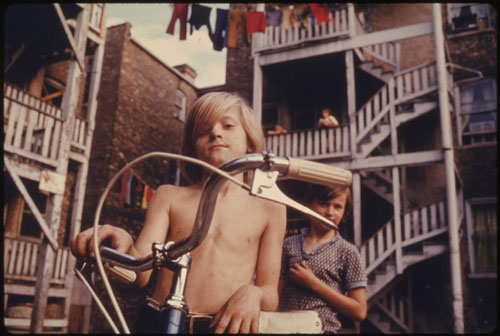
Textify.it is a web app that uses text to make alphabetic pointillist representations of images. I turned a photo of the Most Photographed Barn in America into this:
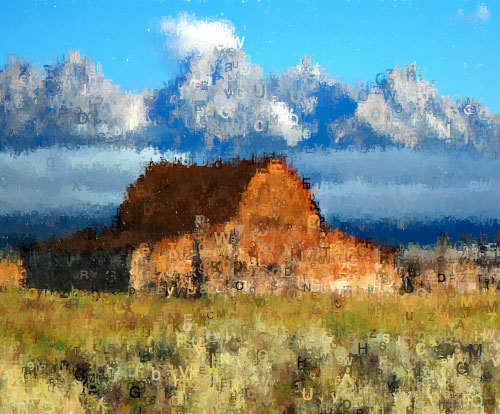
It’s also available as an iOS app. (via prosthetic knowledge)
A great collection of behind-the-scenes shots from famous movies. Here’s Kubrick and Sellers on the set of Dr. Strangelove:
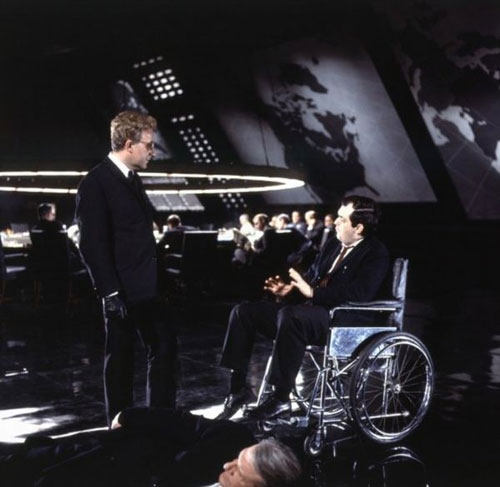
(via df)
Paragliding photographer George Steinmetz takes beautiful aerial photos of Africa and other places from what is basically a chair attached to a motor and parachute.
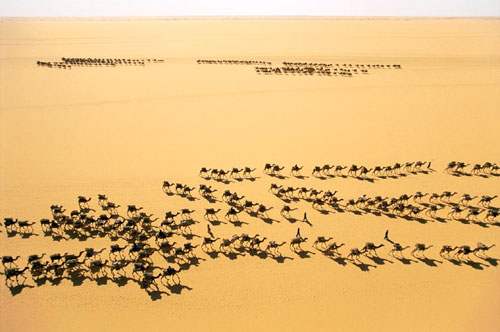
Steinmetz was the subject of a New Yorker profile last year.
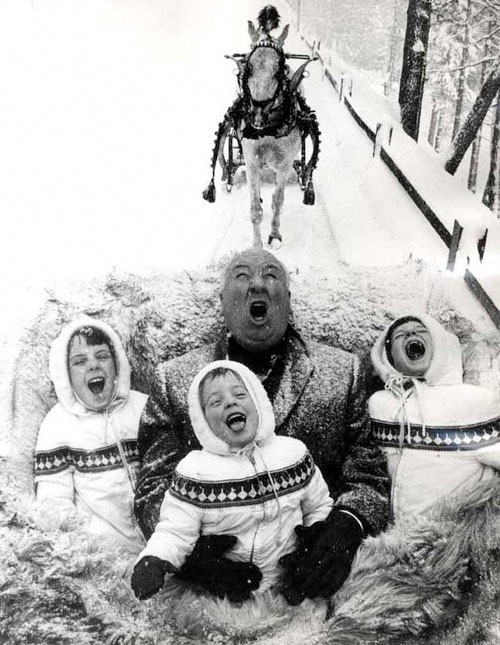
I found this photo of Alfred Hitchcock with three children here labeled “Alfred Hitchcock and his kids” but since he only had one child and looks older in the photo, I assume those are actually his three granddaughters, Mary, Tere, and Katie.
Anyway, lots of other rarely seen celebrity photos here, including a few fakes — notably the JFK/Monroe one done by Alison Jackson — an unheartthrobby George Clooney as a teen, and Hitler’s baby picture. (via ★genmon)
There’s a rock at the main intersection of White Rock, New Mexico that’s often repainted, sometimes two or three times a day. My pal Mouser and a couple friends of his took a core sample of the rock to determine the paint thickness…turns out there was five and a half inches of paint on that rock. Here’s a composite photomicrograph of the paint layers.

LeafSnap is a new iPhone app that uses facial recognition techniques to identify trees based on photos of their leaves.
Leafsnap contains beautiful high-resolution images of leaves, flowers, fruit, petiole, seeds, and bark. Leafsnap currently includes the trees of New York City and Washington, D.C., and will soon grow to include the trees of the entire continental United States.
Wow. Garden Design has more info. (thx, claire)
The recent uploads by your contacts is the most important page on Flickr and it’s broken. Timoni West is a designer at Flickr and she wrote a brief post on that page’s problems.
The page fails on a fundamental level — it’s supposed to be where you find out what’s happened on Flickr while you were away. The current design, unfortunately, encourages random clicking, not informed exploration.
The page isn’t just outdated, it’s actively hurting Flickr, as members’ social graphs on the site become increasingly out of sync with real life. Old users forget to visit the site, new sign ups are never roped in, and Flickr, who increased member sign-ups substantially in 2010, will forego months of solid work when new members don’t come back.
Many of my friends have switched their photo activities to Instagram and, more recently, Mlkshk. And Flickr’s broken “what’s new from your friends” page is to blame. Both of those sites use a plain old one-page reverse-chronological view of your friends’ photos…just scroll back through to see what’s going on. The primary advantage of that view is that it tells a story. Ok, it’s a backwards story like Memento, but that kind of backwards story is one we’re increasingly adept at understanding. The Flickr recent uploads page doesn’t tell any stories.
As long as we’re talking about what’s wrong with Flickr — and the stories thing comes in here too — the site is attempting to occupy this weird middle ground in terms of how people use it. When Flickr first started, it was a social game around publishing photos. You uploaded photos to Flickr specifically to share them with friends and get a reaction out of them. As the service grew, Flickr became less of a place to do that and more of a place to put every single one of your photos, not just the ones you wanted friends to see. Flickr has become a shoebox under the bed instead of the door of the refrigerator or workplace bulletin board. And shoeboxes under beds aren’t so good for telling stories. A straight-up reverse-chron view of your friends’ recent photos probably wouldn’t even work on Flickr at this point…you don’t want all 150 photos from your aunt’s trip to Kansas City clogging up the works. Instagram and Mlkshk don’t have this problem as much, if at all. (via @buzz)
The caption says that this is a photo. My brain is having a difficult time agreeing.
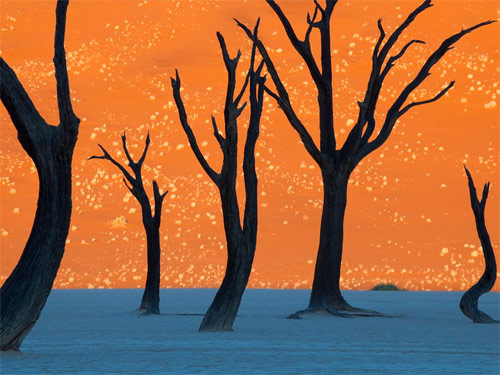
(via stellar)
Murray Howe travelled around Europe in 1909 and these photos of Moscow uploaded to Flickr by his great grandson.
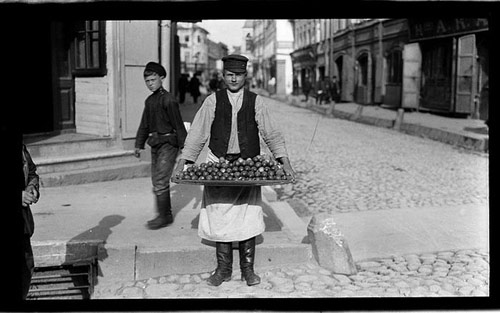
Howe was arrested and detained several times in Russia and Germany for taking unauthorized photographs but still managed to bring his entire collection of photos home with him.
Two hundred and fifty thousand troops were in formal review before the Kaiser. Suddenly a tall, sloping shouldered foreigner stepped into the open, leveled his graflex and snapped it. “Take me to the official photographer,” he suggested, when, the next instant, astounded sword bearers fell upon him from every quarter.
A few minutes later, he had the official picture maker deep in an enthusiastic conversation over some prints showing his work on another day, when foggy weather had foiled the official camera.
After that, it was merely human nature for the Kaiser’s photographer to have his Yankee friend released, and gracefully to exchange prints with him.
Over at In Focus, Alan Taylor posted a collection of nuclear weapons testing photos. You’ve probably seen some of these before, but they’re still worth a look. The photos of the French Polynesian tests are scarily beautiful.
This photo was taken recently by Sergey Ponomarev in Miyagi Prefecture in northeastern Japan:
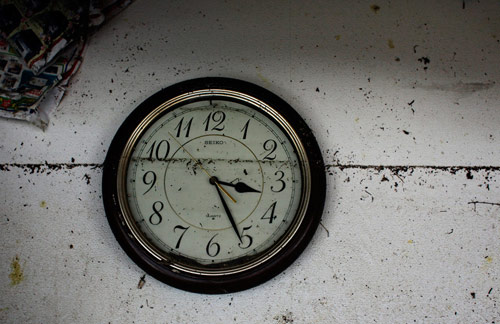
The line on the wall is the high water mark from the March 11 tsunami and the time on the clock is when the water crested (Wikipedia puts the max readings right around 15:20 local time). Each element alone is documentation of a thing…together they tell a story.
I have a soft spot for storytelling clocks in photos. Joseph Koudelka’s 1968 photo of the empty streets of Prague before the Soviet crackdown of The Prague Spring is one of my favorite photos. And obviously I love the photo taken by my wife of me holding my son Ollie when he was exactly 20 mintues old. It was the first time I’d held him and oh crap I’m crying at work again… (via in focus)
From the NY Times Lens blog, a photo essay by Diana Markosian featuring a Ukrainian town near Chernobyl where only five families remain; the rest of the 1000 original residents evacuated after the disaster 25 years ago.
But life can be grim and lonely. Twenty-five years ago, Ms. Masanovitz was a nurse. Her husband was a farmer on a collective farm. Now he spends his time drinking.
While she was photographing the couple one day, Ms. Markosian watched as Ms. Masanovitz picked up the phone in astonishment. It was the first time it had worked in a year.
More photos are available on Markosian’s web site. (via @hchamp)
In the late 70s, Anton Perich built something resembling an inkjet printer to make large-scale paintings like this:
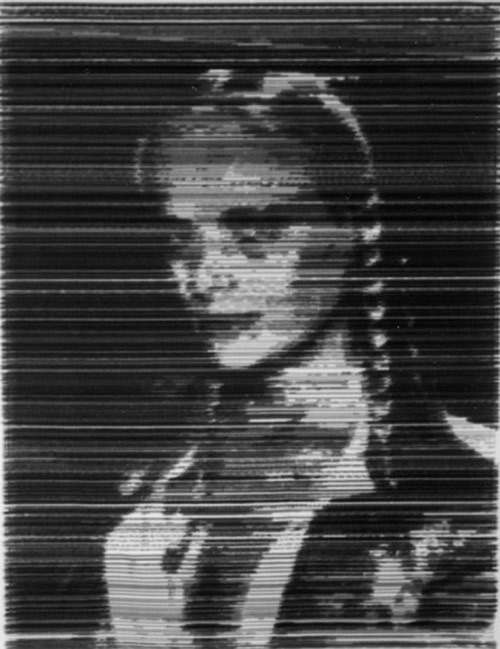
The photography section of Perich’s web site is also worth a look…lots of photos of the Warholish NYC scene in the 70s and 80s: Warhol, Jagger, Mapplethorpe, John Waters, etc. (via today and tomorrow)
The WVIL (Wireless Viewfinder Interchangeable Lens) is a concept camera that uncouples the lens from the viewfinder. Here’s a 60-second demo:
I imagine it wouldn’t be too difficult to make something similar to control a dSLR with an iPhone app via Bluetooth. (via ★pb)
In December 1952, a thick smog settled over London for several days. This was a particularly bad episode of the London Fog, which was hardly a natural occurrence…the “fog” was mostly due to the burning of soft coal. It is now thought that the Great Smog resulted in around 12,000 deaths.
Here’s a collection of photos of the smog, including this daytime shot.
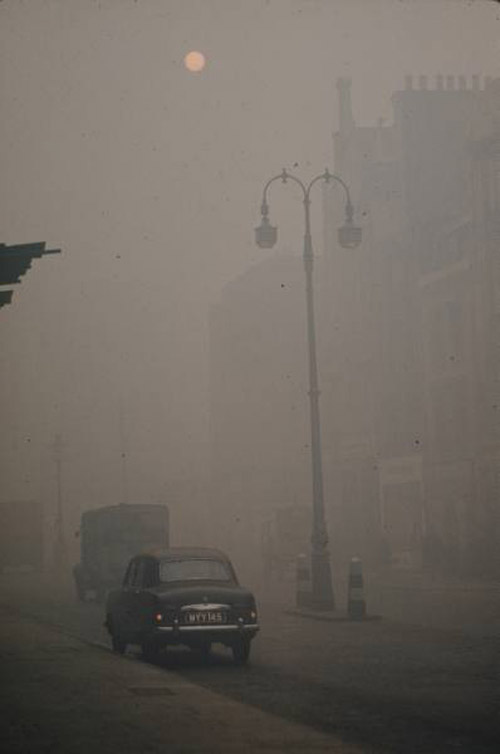
That dim greyish-orange ball in the sky is the Sun.
Great series of photos of a Harlem store front, taken every 2-5 years from 1977 to 2004. (via ★vuokko)
Update: These photos were taken by Camilo Jose Vergara; there are many more like them at his web site. (thx, andrew)
Cute baby animal pix are fine for your daily squee! but for some real gravitas, check out these photos of elderly animals by Isa Leshko.
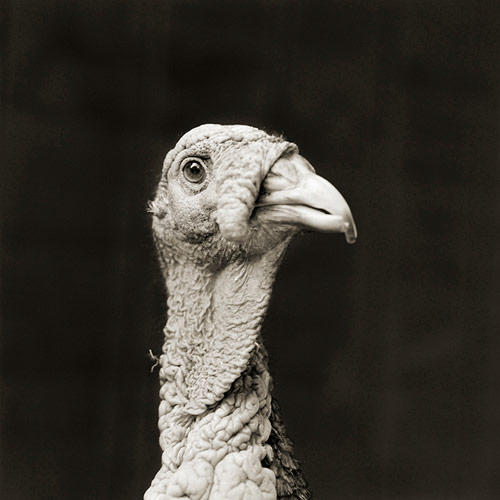
Photographer Isa Leshko is traveling to sanctuaries across the country to photograph animals that are elderly or at the end stage of their lives. “I began the series as a means of exploring my feelings about my mother’s decline due to Alzheimer’s Disease,” she says. “As I’ve worked on this project, though, I’ve come to realize that these images are a testament to survival and endurance. And they raise questions about what it means to be elderly.”
As part of his inventor portrait series, David Friedman profiled Steven Sasson, inventor of the digital camera.
Someone at Yahoo Answers posted the first page of Infinite Jest with the title “First page of my book. what do you think?” The crowd was not impressed:
No discernible voice/tone in this writing. Rambling descriptions. I, frankly, do not care where each and every person is seated. I don’t care what shoe you’re wearing. If you take out all the unnecessary details, you’d be left with about seven words.
See also what happens when a photo by Henri Cartier-Bresson gets critiqued on Flickr.
so small
so blurry
to better show a sense of movement SOMETHING has to be in sharp focus
(thx, timothy)
Stephan Tillmans’ Luminant Point Arrays project is a collection of photographs of tube television screens as they’re switched off.
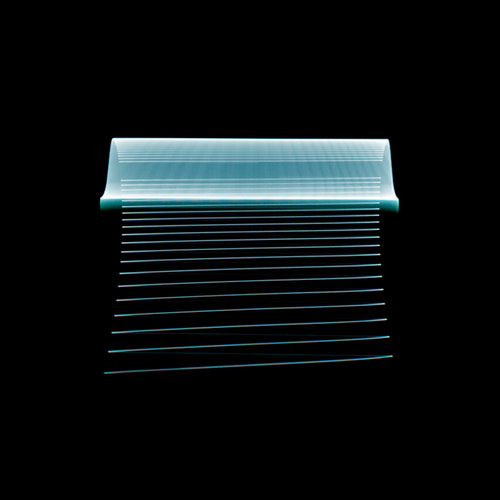
(via ★buzz)
What a great idea…Noah Kalina, Adam Lisagor, William Wilkinson, and Oliver White made an iPhone app that helps you remember to take a daily photo of yourself inspired by Noah’s Everyday project.
Watch closely for the Noah Durden character…
Designer Jessica Walsh shares the photo setup she uses to document her work.
I cobbled together this set up out of the desire to properly archive my design work. Next thing I knew I started getting paid for it, and it became an integral part of my work. I am simply listing my equipment and a little bit about what I know to get some designers started in figuring out the best way to shoot their own work.
You can see the gorgeous results in her portfolio.
Over at The Atlantic’s In Focus blog, Alan Taylor is compiling a selection of photos of the earthquake and tsunami in Japan. You’ve seen many of these on other sites, but not at these sizes (1280 pixels wide).
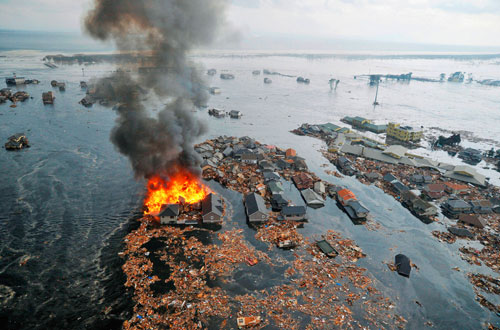
Color photographs of Ernest Shackleton’s 1914 Antarctic expedition by Frank Hurley.

Early in 1915, their ship ‘Endurance’ became inexorably trapped in the Antarctic ice. Hurley managed to salvage the photographic plates by diving into mushy ice-water inside the sinking ship in October 1915.
(via @polarben)
You’ve likely already seen this, but 9-eyes is a better-than-usual collection of images taken from Google Street View.

Stay Connected